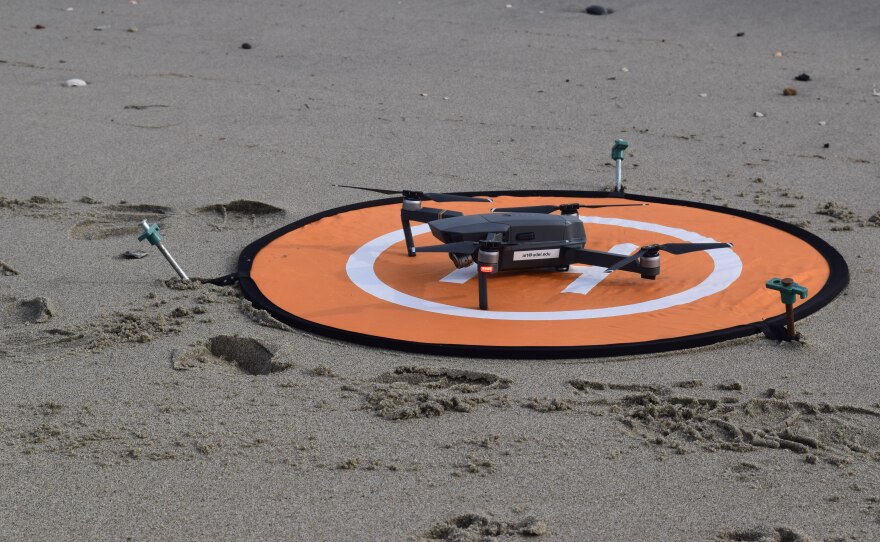Four coastal storms battered the East Coast last month. Three of them took bites out of some of Delaware’s beaches, causing minor to significant erosion and even damage to beach walkways.
Walking on Broadkill Beach after last month’s cluster of coastal storms, it was clear the storms packed quite a punch.
“I see a ton of debris that’s out here, definitely a lot of build-up of sand along the fences, because I think the storms have consecutively just been hitting back to back to back,” said Stephanie Dohner, a University of Delaware PhD oceanography candidate.
Dohner and lab technician Hunter Tipton are launching two drones about 200 feet into the sky to track wave movement and changes to the beach’s shape.
The first drone hovers in the air taking video as waves move toward the shore, so the scientists can calculate how deep the water is.
“The bay is very shallow,” Dohner said. “If we get just rolling swells from nor’easters and tropical storms, the whole bay might be moving.”
Dohner says before a nor’easter, not much sand fills the water from the surface to the bottom.
“And then these storms come through and the whole water column is just filled with sediment and biological things,” she said. “That’s the cool part because that's when you know stuff is moving.”
As winds move the sediment around in the water, the seafloor changes.

They use a second drone to take photos of the beach. The drone communicates with a computer to take snapshots. The snapshots taken help the scientists compare the shape of the beach before and after the storms.
Scientists say if one storm erodes a beach and the beach does not have enough time to build itself up before another storm hits, that beach will fare worse because it couldn’t recover between storms.
It’s similar to rebuilding your immune system after a cold or fever, Dohner said.
“If you get sick, and you get better and you’re feeling good for a while, your immune system is back up and it can probably fight off the next cold. Otherwise if you’re sick and you get sick again, it’s just a continual bad feeling all the time,” she said.
Delaware’s beaches have seen worse from single nor’easters.
Delaware State Climatologist Dan Leathers says one particular storm comes to mind: March 1962 — a single nor’easter over three days and six high tide cycles.
“There was some pretty intense wave action with those too and [they] just caused a lot of damage. Flooded, took boardwalks out along the Delaware coast…” Leathers said.
But why haven’t we seen a nor’easter like that since?
“It’s very unusual for these storms to stall and not move,” Leathers said. “It does happen. In fact, one of the nor’easters this year sat for the better part of the day without moving.”
He continued, “But to really sit in the same position and just sit there and spin for three days right off the coast is very unusual.”
Leathers says Delaware tends to see nor’easters as winter turns into spring. Warm, moist air masses migrate up from the south, as cold, dry air moves down from the north.
“And it’s where those two air masses intersect where you very often get the development of these storms,” he said.
There’s another ingredient in the nor’easter cocktail besides the air masses — a pattern in the jet stream called a “trough” that dives down to the south.
“In this case, we had that trough sitting there for several weeks,” Leathers said.
According to the National Weather Service of Mount Holly, New Jersey, Delaware saw coastal storms between March 1-2, March 6-7 and March 20-21. Meteorologist Tara Johnson said the first March storm had northwesterly winds, while the other two storms were nor'easters.
Additionally, a March 13 nor'easter affected parts of the East Coast, but not Delaware or Southern New Jersey.
"There was certainly such a high impact from all four storms, especially as we were coming off of February being much warmer than normal," Johnson said.

"We would have to factor that into our defenses for the coastline."
As the Earth warms over time, and sea levels are predicted to rise at a faster pace, these March storms could get more intense. Higher sea levels make beach communities more prone to flooding.
UD oceanography and geology professor Art Trembanis says when sea levels rise, Delaware needs to be ready.
“We would have to factor that into our defenses for the coastline to consider that actually maybe we need to increase the number of nourishment episodes or decrease the interval of nourishment activities if we’re going to maintain beaches at their present status, if we’re going to have more storm clusters,” Trembanis said.
Trembanis said when one nor’easter hits, there’s a good chance the beach can naturally recover in time for the summer tourism season. But if a beach sees a storm cluster, it has more work to do.
“The combination of them can set the beach into an erosional state that means that there’s maybe less recreational beach, or more work needs to be done to build the beach back up to defend it for subsequent storm attacks,” Trembanis said.
The beaches at Bethany Beach, South Bethany and Fenwick Island are set to get more sand this summer. If federal funding allows, the Army Corps of Engineers says Broadkill Beach will get more sand in 2021 to help it fare better in the face of storms.
Whether or not it will hold up for the next three years depends on what Mother Nature has in store.








